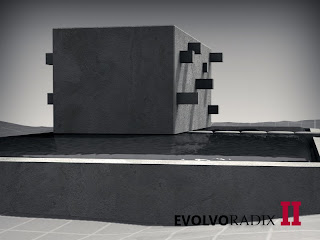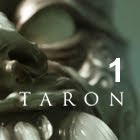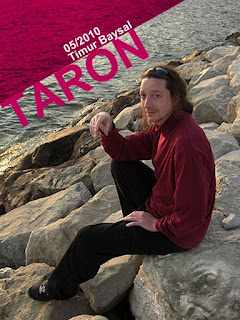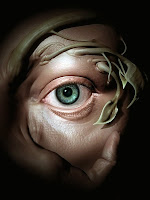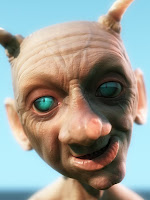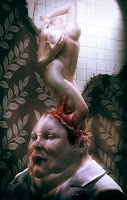Taron continues to share his insights and experiences.
The
previous part covered topics on education, mentor roles, his beginnings with art and computers.
In part two, he shares his take on creative theories, software, and the VFX industry. - "...understand - that you not only enjoy yourself along the way, but truly deliver something with the least amount of heartache."
The Interview, part two:
7. For new art talent that wants a professional career in their chosen field, what should they think about, when it comes to locality, expertise field, motivation, inspiration, and training?
Maybe it's not even all that surprising to understand that it really depends on the chosen field itself.
What has been your motivation, where do you want it to take you; is the activity itself all of you wanted, or did you pick it as the means to gain more freedom for something else?
All these things pull, push and nudge the direction of your path or even alter the nature of your career from path to destination. It's a very big step already, to realize what you really want. In fact it's nearly an impossible step, should you become aware of the nature of your own transformation.

Therefore, it's most important to understand where you can apply yourself wholeheartedly, so that you not only enjoy yourself along the way, but truly deliver something with the least amount of heartache.
I wouldn't be too worried about the fatigue issue, as it is mostly related to the relentless working conditions in the industry or the potential under-appreciation of the scope of your skill set at the same time.
Be worried about losing your believes and your self-definition along the way. It's your life, don't ever forget that, and it's not about delusions of grandeur, but about prolonging your ability to function to the best of your abilities.
Be selfish, when it comes to picking your profession, the field you can hang with, so to say. It's your passion you offer for sale out there and it's the most valuable possession you have.
Move on, by the time you realize the pile of stagnated moments pokes a hole into the roof of your head, you'd starve a part of yourself that you cherished a lot earlier.
Some people comfortably feed on such moments, which is why it'll never be a threat to their head, but most artists must have had an urge that pushed them into this business, but it can only find dissatisfaction by the time they realize that it was in their power to conceive ideas and not translate them.
The training for all artists should ultimately be nearly exactly the same. We all have tasks that require us to create communicative content. Learn to understand what humans perceive. Nature is the ultimate teacher.
Whether we'd been planted here by aliens or are earth grown sentinels, we have adapted to react to life on earth, to structures in nature and concepts that help us survive and feel secure or properly challenged. All of these things come from nature. All of the required forms have been erected by nature.
We often try to simplify in hopes to optimize, while we produce something that nature doesn't even know, which is something to be frozen for all of infinity. However, all the major lessons should come in direct connection with nature.
You may move forward by removing yourself from the direct line to it and observe the interpretations of nature, but that's where misguidance and unoriginality is lurking. Do all of the learning yourself and you'll be as independent as you can be and you can reveal your very own transformations, revelations and imagination.
8. You beta test many types of software, which are the latest ones you tested and are worth talking about?
Sculptris. It has been a tiny little 3d doodle toy that Tomas Peterson began writing a while back. But when people started to recognize the simplicity of it and the harmless beauty of creating useless 3d designs, he somehow did get a giant boost of motivation and started to program the living daylights out of it.
By now it's already one of the most amazing 3d sketching tools ever created, actually. I'm not even nearly kidding, since it does approach the topic in a very different and quite benign way.
It requires no premeditation like in pretty much all other apps out there, while it creates geometries that can later be used either directly for rendering and animating in other apps or as a base to start from in things such as Zbrush, still king of kings in the world of displacement map creation and drowning helpless little objects in stunning details, haha.
Anyway, Sculptris has a unique work flow that just makes you forget completely about technicalities, at least more than anything I've ever witnessed or cared to witness, really. It's still polygon based, which means it's not some curious but scary voxel solution that falls crying to its knees wants you want to celebrate your illusion of freedom.
Sculptris doesn't blow the lid off high polygon counts, but it works beautifully and intelligently right up to your machines waving of a white flag. Then it permits you to take it all for the next big ride, which is painting color, bumps and unlimited materials on top of that geometry, again in unseen before comfort and fun, really.
It's changing the idea of 3d in more fundamental ways than Zbrush had already suggested. While I stand by what I said above about Zbrush, Sculptris just takes it a bit further by really simplifying the process to the easiest possible level thus far.
I thought it was a nice gimmick when I started playing with it and found myself depending on it only a day later, really.
True 3d sketching!.
And Tomas, the developer, is such a bright light, it's a blast to watch him grow his little tool.
I think, when people talked about how fun it is to watch me sculpt something, it's that kind of fun to watch him create, really. And it's just as fast, too. I'm thrilled now, because I know it's been happening already and even if the sky were to fall and he turned into a homicidal slacker while the tool imploded, that which he has already made me witness is priceless.
9. As most creatives you dabble in other fields as well, I heard music was one of those, how come, and what draws you to that field?
Ultimately I want to communicate, I guess. I'm so full of micro revelations, urges to confirm, to share, to connect and the shear pleasure of experiencing the transformations of what comes out through me right before my eyes or straight into my ears.
But as I've written already, and said so many times, the real thrill to me is the collaboration with the medium. It's such a magnificent amount of presences, if that's still ok with the English language. I'm referring to the layers of participants in the process of working on computers, or even playing an instrument.

You tickle a piece of it and it vibrates through the entire system until something divine comes out on the other end. The great benefit on the computer is that you can store it and witness it again and again and grow it, help yourself to evolve your own connection and command to create and mature ideas. This provides you with the seasoning of life, the inspiration and meditation that takes you to the known right through the unknown.
Music is the honest truth, the one you can have for yourself and offer to others without sacrifice unless you submit yourself to their pleasure. Music can so easily be innocent, it can reveal parts of you that words can't ever dream of illustrating and when you're strong enough, you can make that music twist you into what ever state you'd like to be.
It's the organic transporter that grabs you with its invisible fingers and pulls you into your own imagination and pushes you into it, or let's you slumber in peaceful reflections of all that you love.
I am what music allowed me to be. That kinda draws me into that field.
10. What are the biggest differences between Europe and the US when we are talking about the creative fields you have been involved in, and what did you learn from it?
I can't speak for all of Europe, really, especially not since I am from Germany, which in so many ways appears to be exceptional. Haha!.
I can only speak of some of my experiences with artists and aspirators of neighboring countries. Generally, it appears that by nature they are all rather humble, yet pushed into an unnatural need to compete with the US spirit, which somehow makes many artists there believe it's clever to claim high quality just as long as you believe yourself that you can deliver it, hahaha.
It's not the US artist's fault at all. I think it's not unusual that Europeans don't think about it in that kind of forgiving way, as they don't know how beautifully supportive American families generally are and the kids really grow up thinking they are in fact the greatest ever and the good teacher tells them to claim to be the best in order to make sure their client knows.
Then, when the truth comes crashing down on them, they get terrified and spiritually curl up underneath their desks. They often have great talent, but their mouth simply has been stretched to be just a bit greater than that.

Eventually the talent catches up and they become known for their brilliance to the industry, or it doesn't and they become known to the industry for other reasons. European artists used to have to go through a not so supportive growth, being doubted for their choice to become an artist to begin with and being denied the title "artist" for the longest time even during their actual careers in the field.
They can get horribly arrogant, don't get me wrong, but it's often extremely well backed up by what they can do.
The southern countries, however, have a stunning number of excellent artists, who's liveliness makes occasional flares of arrogance more than forgivable and their style is often beyond delightful, really. My Italian artist friends mean a lot to my heart and, while I feel related to artists all over the world, they will always have a special meaning to me. I think I want them to be my brothers, haha.
I still have to encounter the local artists where I am now.
I've already had contact with one, who seems to have a wonderful spirit, too, and is madly talented.
Every culture has a certain degree of authenticity that just doesn't go away, no matter how much they had been influenced by contemporary concept art orgies of Hollywood. Often it's that heritage that people in Hollywood respond to without knowing it, and soon they want to have it for themselves.
But as most humble Europeans do, they try to adapt, at the beginning being pushed to do so and at the end being brainwashed to continue, and it always takes a while for them to snap out of it again, if they're lucky, haha.

The meaning of our art is being pulled from beneath our feet and the potential of its true function is being tied down into the engines of a system that appears to have no interest in raw and true human growth.
We can't transport a true past experience through our creations, nor can we rely on the cultural foundation to be advantageous for our understanding of how to continue.
While art has always been our most explicit means to carry on that which goes directly above our immediate needs. This brings us back to a more direct answer to the question above.
The system of Europe still has roots that reaches into the field and the pride of art. Aware of the cultural evidence of art, it is a matter of status to respect the creative fields in Europe, and it still serves as a role of satisfying the sense of identity for its citizens.
I feel truly inadequate to even voice my deductions and impressions in any way that may suggest that I know, or had any right to judge a field.
But I know that there's more innocence in European art than in that of the US, as artists there -unaware of its origin and permanent influence- often follow the call of success, popularity and wealth as opposed to the artistic subject itself, the respect it demands and it's requirements.
Forgive me, if I generalized this topic to some degree, as I know that this may insult some, while others understand that I don't mean to judge or to blame, but to inform that true power and joy is in the sincere devotion to an inner calling.
That it manifests itself and its selfishness, not in pride or parade, but in humility and the love to share the stimuli that helps everyone to grow as humans, and help each other to become the best we can be, to create the best we can imagine.
Taron
Timur is also part of the core group of advisory artists at MI -
Link Of importance also is the stability of the floating object. Generally, the floating object should have vertical stability. If the object is inhabited by people, it will push down slightly, but the added weight is of such little increase in light of the total mass of the building, that this is of little physical consequence.
Of importance also is the stability of the floating object. Generally, the floating object should have vertical stability. If the object is inhabited by people, it will push down slightly, but the added weight is of such little increase in light of the total mass of the building, that this is of little physical consequence. 





